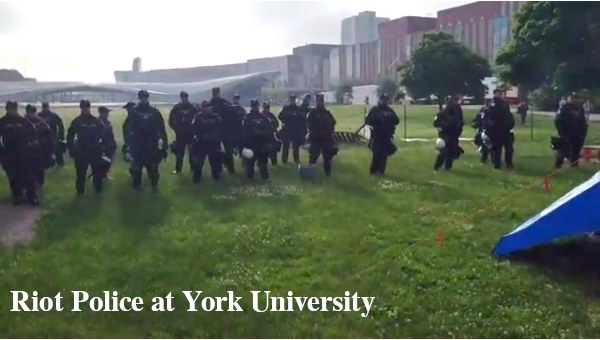A New Strategy for Higher Education
In the British Labour Party’s 2017 election manifesto, the pledges to abolish university tuition fees and reintroduce maintenance grants were widely seen as vote winners, but that was the extent of the party’s policy commitments toward the sector. Since the election, Labour has supported staff and students in challenging the yawning gap between highly-paid vice-chancellors and principals on the one hand, and part-time academic staff whose work is extremely insecure and poorly paid; and it has supported the industrial action that academic and administrative staff in UCU have taken in defence of their pension rights.

Important though these issues are, Labour’s policies need to be based on a much more comprehensive analysis of the problems in the sector, framed by the ways in which higher education fits in to our wider economy and society. In short, Labour needs a new strategy for higher education. In what follows, I set out key elements of such a strategy, looking in turn at:
- the overall purpose of higher education (HE);
- management control and the erosion of collegial culture;
- growing differentials in pay and job security; and
- the withering away of part-time and adult education in HE.
What is Higher Education For?
Ever since the 1963 Robbins Report, two principles have remained unchanged: making HE available to all who can benefit from it; and meeting the needs of the economy for skilled labour and knowledge. However, from the 1980s onwards these principles were pursued in the context of a renewed liberal economic philosophy, centred on individual achievement and national competitiveness. As a result, the expansion of student numbers came to be increasingly driven by the allure of a “graduate premium” in life-time earnings, while research was oriented toward improving UK competitiveness in an increasingly global economy, especially through closer links to the private and public sectors.
Labour’s policy through 1997-2010 continued in this vein. The government expanded HE participation toward 50% of the 18-24 age group, and sought to shape the patterns of teaching and research to the needs of the economy primarily through financial incentives. Since the crisis of 2008, there has been a radical acceleration in the role of money and markets, with a major shift in the funding of teaching from central government grants to student fees, and of research from public grants to commercial contracts.
Despite the undeniable successes of UK HE in conventional economic terms, the increasing role of markets has led to significant debate about the wider societal purpose of the sector. Critics have gone back to the concerns of Mill and Arnold (echoed by Robbins) – universities as bearers of public culture and core values, focused on improving the lives of all rather than the profits of the few. While such criticisms cut little ice with committed supporters of the free market model, there is now mounting evidence that they cannot ignore concerning the actual outcomes for students and society. The Economist reported recently1 that the size of the graduate premium has been widely overstated, and that degrees are often used mainly as a way of simplifying recruitment processes to jobs for which graduate skills are not really required. The report argues further that from the point of view of society, the actual premiums accruing to individual graduates are significantly offset by the loss of earnings among displaced non-graduates.
More broadly, universities need to address the ever-deepening educational divide in our society, which many believe has been a key factor in the rise of the new populism, both in the UK and across the developed world. As the research of Diane Reay and others has shown,2 HE remains a major factor in reproducing social inequalities of class, race and gender. In this view, universities should be genuinely universal, as educators of all and as repositories of knowledge for society as a whole.
Markets, Management and Metrics
We are all familiar with the central role of the privatisation of state enterprises in our economy since 1979, but equally important was the ‘new public management’ model which has transformed governance in those parts of the public sector which traditionally did not directly sell their services for money. The HE sector adopted this model in the 1990s, seeking to incentivise both teaching and research through performance measurement (initially Teaching Quality Assessment and the Research Assessment Exercise).
Already by 1997 Michael Power’s study The Audit Society showed how the ‘carrot-and-stick’ private-sector model of top-down management control had spread to the public sector, transforming the culture of an increasing range of organisations. In HE, this new model has seen a major shift in decision powers from academic staff to executive managers. While academics still take part in senior management, the methods and culture of governing bodies have increasingly been shaped by professional executives, partly as a result of the co-option of external members largely drawn from the private sector.
Put simply, the carrot-and-stick approach is based firmly on the assumption that subordinates are motivated solely by a calculus of individual effort and reward, seeking to maximise their financial gain in competition with all others. Such an approach is intrinsically dehumanising in any context, but with the complex nature of teaching and research outputs, relying on ‘metrics’ to assess performance is especially hard to justify.
This top-down and reductionist approach to management has been experienced by many HE staff as profoundly disempowering and oppressive. Both teaching and research are collective activities, motivated by the desire to understand the world and to transform it for the better, rather than by money. The traditional culture of ‘collegiality’ could indeed conceal inefficiencies, but trust and mutual aid were nurtured within it, and these have been greatly eroded.
Labour’s HE strategy should promote governance processes and cultures that build effective management upon a renewal of collegiality and democratic participation.3 Some degree of protection from both immediate market forces and top-down managerial control should be part of this.
The Effects of Financial Uncertainty On Pay and Conditions of Employment
Following the 2011 Higher Education White Paper, the Coalition government introduced major changes in the financing of HE and in the regulation of student numbers.4 The shift from block grants to student fees for meeting the costs of teaching, coupled with the removal of caps on recruitment, appeared to ‘free’ providers from direct state control, and instead subordinate them to market competition. This was intended to lead to more diverse provision, with a wide range of fee levels and a greater responsiveness to changes in the patterns of demand for highly-educated labour. Seven years later, the vast majority of ‘home’ undergraduate students pay £9,000 a year, and the sector seems to fare no better than before in terms of addressing skill shortages.
More importantly, the shift from a largely planned model of governance to one of regulated competition has exposed the utter failure – of both the government sector leaders – to appreciate the obstacles that market competition inevitably faces in HE. These difficulties arise not from any opposition among staff and students, but because modern free-market economics has very largely forgotten to take into account the structural conditions that the newly-freed market faced. For a hundred years, orthodox economics taught that efficient market outcomes required easy access for new entrants, and resource inputs readily to hand and flexible in use: these conditions have never applied in HE, and indeed provided a mainstream (pro-market) rationale for putting the provision of a wide range of such goods and services within the public sector.
Developing new capacity in HE – new courses, new staff, new infrastructure such as housing and learning resources (IT, libraries) – requires substantial up-front investments and takes a significant amount of time. Universities have responded in part by seeking external finance based on future revenue streams, taking advantage of historically low interest rates, but still increasing their debt levels substantially. But the unexpectedly slow pace of recovery since the 2008 crisis, accentuated more recently by Brexit, has led to deepening concerns over the stability of the new system. This has given rise to a range of precautionary responses that are affecting staff at all levels.
First, the shift in power from academics to managers has accelerated. This is partly seen in the centralisation of actual decision-making processes, and the prescriptive imposition of a corporate financial mind-set at all levels of management. It is also seen in the sector’s adoption of pay relativities that increasingly resemble the private sector, with vice-chancellors and principals earning far more than heads of NHS Trusts or chief executives of large local authorities. Typically, strategic decision-making in a university is now exclusively reserved for the Council, with Senate’s role limited to strictly academic matters. Governance arrangements increasingly lack external transparency and accountability, e.g. in relation to remuneration committees for vice-chancellors.
Second, the financial risks associated with a competitive market environment have been offset by reducing the cost and increasing the flexibility of the labour force, through the growing use of fixed-term and/or part-time teaching staff. Any suggestion that this is morally equivalent to the employment practices of Sports Direct, Amazon or Uber is of course greeted with howls of outrage.
Third, universities have sought to cut the costs of full-time academic staff through re-writing university statutes in order to reduce employee protection, and now through a coordinated attack on the pension rights of permanent staff; in both cases, the result has been unprecedented levels of industrial action by those staff, with growing support from students.
Access to Higher Education
Thirty years ago, most universities offered schemes for mature entry, and at least some part-time provision of their degree-level programmes. They also provided a wide variety of extra-mural or continuing education opportunities: not only vocational and professional courses leading to qualifications (including many designed for trade unionists), but also traditional ‘liberal arts’ courses taken by local citizens motivated only by a desire to learn.
Since the 1990s, the scope of such ‘non-traditional’ programmes has narrowed almost completely to vocational provision, related to specific job needs or state-accredited return-to-work programmes. This approach has displaced the extra-mural educational purpose which originated in the late 19th century world of Mill, Arnold and Ruskin, and which for a hundred years or more helped to ground universities in the communities surrounding them.
More recently, the sharp rise in student fees since 2011 – albeit deferred in the form of student loans – has been accompanied by sharp falls in the numbers of mature students (defined as those over 21 who have not undertaken any HE already) and part-time students. In this case, the relentless process of marketisation has revealed a serious flaw in the debt-based fee model: older entrants are likely to be already indebted through mortgages or consumer debt, and will have fewer years in which to repay the loans. Not surprisingly, universities prefer to avoid the costs of attracting and preparing such reluctant customers, and focus instead on poaching 18-year-olds from each other.
The role of HE in reproducing social and economic inequalities has already been noted, but we need to see this in relation to the deepening social divisions revealed by the rise of populist politics, and particularly by the EU referendum campaign and its aftermath. Support for Brexit was greatest in towns and counties which either had no HE institutions, or the lowest levels of HE participation by 18-21-year-olds.
It is often argued that the over 50% of our population who do not go into HE should not be expected to shoulder its cost in public support through their taxes. The traditional liberal answer to this is that they do benefit, albeit indirectly through economic growth, better-quality goods and services and improvements in productivity.
But perhaps a more telling response is to argue that a truly universal university system would be designed to meet the life-long educational needs of all our adult citizens. This idea lies behind the recent proposal for a National Learning Entitlement (NLE), providing each person with a fund on which they could draw at any time in their life to meet part of the cost of whatever studies they found appropriate to their needs. An NLE would naturally fit in to a strategy of making HE an integral part of Labour’s proposed National Education Service, bringing the universities firmly under public control. Ideally, this would be accompanied by a devolved system of governance in which HE provision would be tailored to local and regional needs.
Conclusions
The Labour Party’s policies on higher education need to be based on a thorough critical appraisal of the UK’s current market-driven approach, building an alternative strategy based on reducing social and economic inequalities through making knowledge available to all. One element should certainly be the abolition of tuition fees, coupled with the reinstatement of means-tested maintenance grants. Four strategic purposes are suggested here:
- a genuinely universal role for universities in the service of the public interest, not individual gain;
- the governance of HE institutions to be rebuilt around their public purpose and democratic control, not market competition and financial metrics alone;
- staff pay in HE based on greatly-reduced differentials, with security of employment for all;
- HE as an integral part of Labour’s proposed National Education Service, providing direct benefits, both material and cultural, to all citizens. •
Endnotes
- See “All must have degrees,” The Economist, February 3rd 2018, p.56-7.
- For the latest research see Richard Waller, Nicola Ingram and Michael Ward (eds), Higher Education and Social Inequalities (Routledge, 2018).
- A pioneer of the modern management system in HE was Warwick University in the late 1960s: see E P Thompson (ed.), Warwick University Ltd.: Industry, Management and the Universities (Penguin, 1970).
- See Andrew McGettigan, The Great University Gamble (Pluto Press, 2013).





